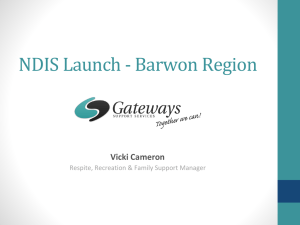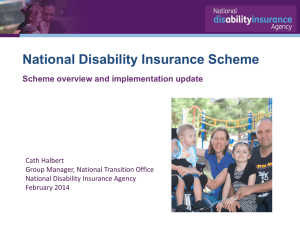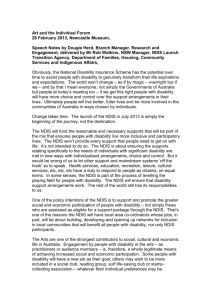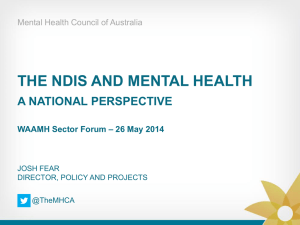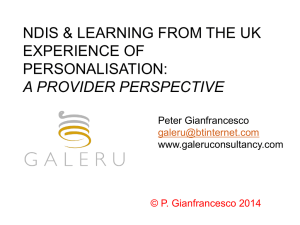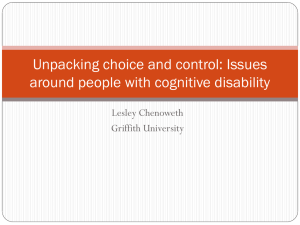Louise Glanville (372k ppt)
advertisement
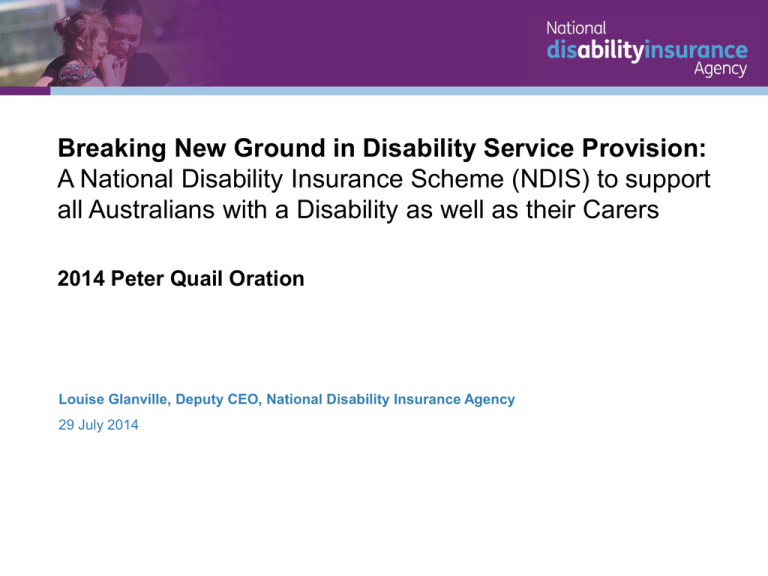
Breaking New Ground in Disability Service Provision: A National Disability Insurance Scheme (NDIS) to support all Australians with a Disability as well as their Carers 2014 Peter Quail Oration Louise Glanville, Deputy CEO, National Disability Insurance Agency 29 July 2014 Background to the NDIS trial 2008: The former Government’s 2020 summit proposes a national disability scheme 2010: Productivity Commission conducts enquiry into long term disability care July 2011: Productivity Commission submits report to government December 2012: Council of Australian Governments sign an intergovernmental agreement to trial the Scheme October 2011: Council of Australian Governments agree to the need for reform – joint taskforce develops Scheme design March 2013: NDIS Act 2013 establishing the NDIS and NDIA passed April 2013: Bilateral agreements with trial sites signed Heads of Agreement are now in place for full Scheme in NSW, SA, ACT, Tas, Vic and Qld 2 Scheme principles • People with disability have the same right as other members of the community to realise their potential • People with disability, their families and carers should have certainty that they will receive the care and support they need • People with disability should be supported to exercise choice in the pursuit of their goals and the planning and delivery of their supports • The role of families and carers in the lives of people with disability is to be acknowledged and respected 3 Three key pillars underpin NDIS design Insurance Approach Choice and Control Supports economic and social participation. Participants determine how much control they want over management of their funding, supports and providers Mobilises funding for early intervention Estimates and manages resource allocation based on managing long term costs across the life-course of individuals Shares the cost of disability across the community Scheme gives effect to certain obligations under the Convention on the Rights of Persons with Disabilities - including respect for their worth, dignity and to live free from abuse, neglect and exploitation Community and Mainstream People are supported to access and coordinate community and funded supports The scheme will not duplicate or replace mainstream services Effective interface with mainstream and community supports is central to the sustainability of the Scheme 4 The National Disability Strategy and the UN Convention • The National Disability Strategy 2010 – 2020 represents a significant milestone in the development of disability policy in Australia • It provides a shared vision for an inclusive Australian society that enables people with disability to fulfil their potential as equal citizens • It is an important mechanism to ensure the principles underpinning the United Nations Convention on the Rights of Persons with Disabilities are incorporated into policies, services and programs • The Strategy sets out a 10-year national policy framework to drive reform in mainstream and specialist disability service systems to improve outcomes for Australians with disability, their families and carers 5 Key Policy Areas for Action under the NDS • The National Disability Strategy sets out six priority areas for mainstream reform. • These priority areas are aligned to the principles underpinning the United Nations Convention on the Rights of Persons with Disabilities and were developed in consultation with people with disability. They are: – Inclusive and accessible communities – Rights protection, justice and legislation – Economic security – Personal and community support – Learning and skills – Health and wellbeing 6 The impact of the NDIS…. 7 Trial sites are established and expanding On 1 July 2014, the second year trial of the NDIS trial commenced in: • South Australia • Tasmania • The Hunter area in NSW and • The Barwon area in Victoria On 1 July 2014, the first stage of the NDIS trial commenced in: • Australia Capital Territory • Northern Territory • Western Australia commenced a two year pilot 8 Scheme achievements At the end of the March 2014 quarter • Over 6,400 participants were eligible for the Scheme • More than 5,400 participants had an approved plan • Participant satisfaction with the Agency was over 90% • 1,400 providers were registered • The Scheme is meeting its bilateral phasing targets and delivering within the funding envelope 9 Benefits significantly exceed the costs • Comparison of NDIS should be with future expenditure in the absence of the NDIS, not current expenditure • In 2012 PwC estimated that the cost of disability would increase to $35-45 billion • This would exceed the costs of the NDIS by 2023 • The Productivity Commission concluded that: • an NDIS would result in an additional 320,000 people with a disability employed by 2050 – resulting in an additional $32 billion or 1% of GDP – based on conservative assumptions • that in addition to people with a disability benefiting from the NDIS in terms of employment, so will their carers, and • an additional 80,000 carers would be employed (or be able to work more hours) seeing a $1.5 billion increase in GDP per annum 10 How things are changing under the NDIS Feature Former system NDIS Access criteria Vary from state to state Nationally consistent as set out in legislation Choice and control Varies from state to state - most people have little say over the supports they receive Individual has control over the type and mix of supports, delivery and how their funding is managed Level of assistance Capped – people may be eligible but can spend years on waiting lists Demand driven – people with disability get the support they need, when they need it, to make progress towards goals Funding Multiple programs within and across governments Single pool of government funding administered by NDIA 11 The impact of the NDIS A young man with a spinal cord injury in the Barwon region previously needed the support of two carers per day to assist him inPlanand out of bed and to help NDIS number 123456789 10/04/2014 with daily activities. Baseline Scenario 1 Comparison A 35 year old male with a primary diagnosis of multiple sclerosis. Implementing an intervention over 1 quarter at a cost of $28,000 There is an ongoing reduction in future support costs of $73,000 p.a. Scenario 1's lifetime cost is $1,402,708 lower than the baseline scenario Scenario 1's cumulative cost will first fall below the baseline scenario in 0 years (at age 35) Under the NDIS a ceiling track hoist was installed in his home which is being $ 1,402,708 $ 4,644,245 $ 3,241,537 used to assist his mobility. He now needs the support of just one carer. Lifetime cost Lifetime cost Savings Cumulative Cost $16,000,000 This change immediately $14,000,000 $12,000,000 reduced his dependence, while also reducing the cost $10,000,000 $8,000,000 $6,000,000 of his supports by more than $1 million over his lifetime. $4,000,000 $1,404,300 $2,000,000 X$166,800 $140,050 $0 35 37 39 41 43 45 47 49 51 53 55 57 59 61 63 65 67 69 71 73 75 77 79 81 83 85 87 89 91 93 Age 12 The societal impact of the NDIS • The NDIS will provide care and support to over 400,000 people (at full Scheme, in 2019-20) with permanent and significant disability. • The Scheme will in total affect an estimated 1 million Australians. • The Agency also plays a roll in breaking down stereotypes. • The Agency will promote the inclusion of people with a disability into mainstream society. • The Scheme will also assist families and carers to have the opportunities to be more involved in the community. 13 Keep up-to-date by registering at: www.ndis.gov.au Follows us on: Twitter: https://twitter.com/NDIS & Facebook: https://www.facebook.com/NDISAus

